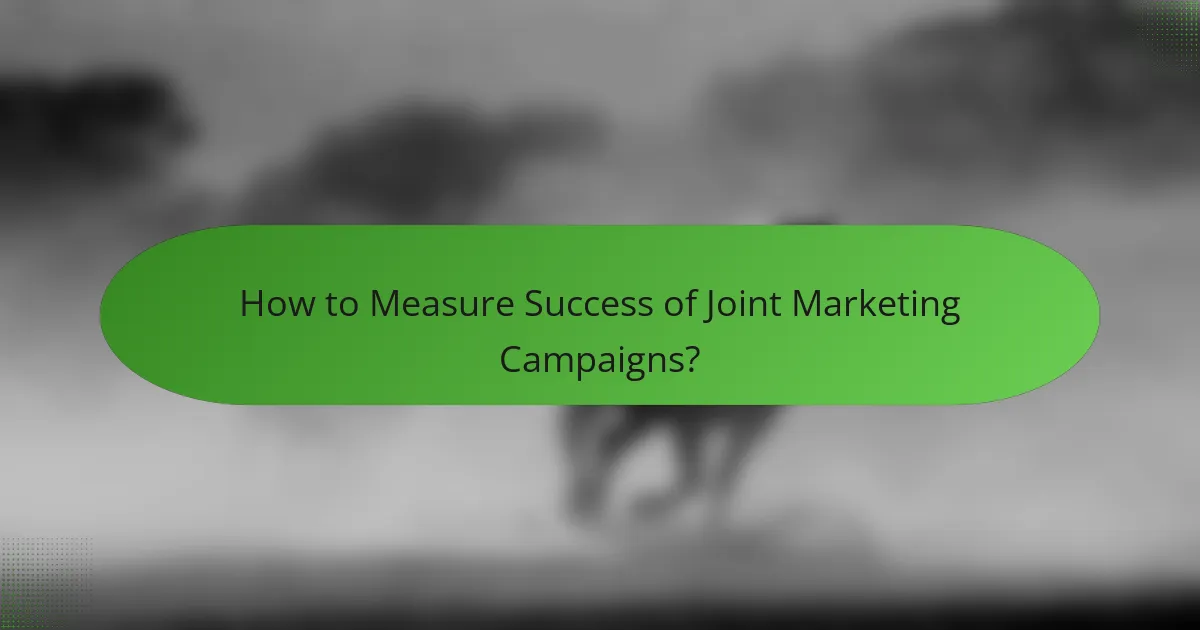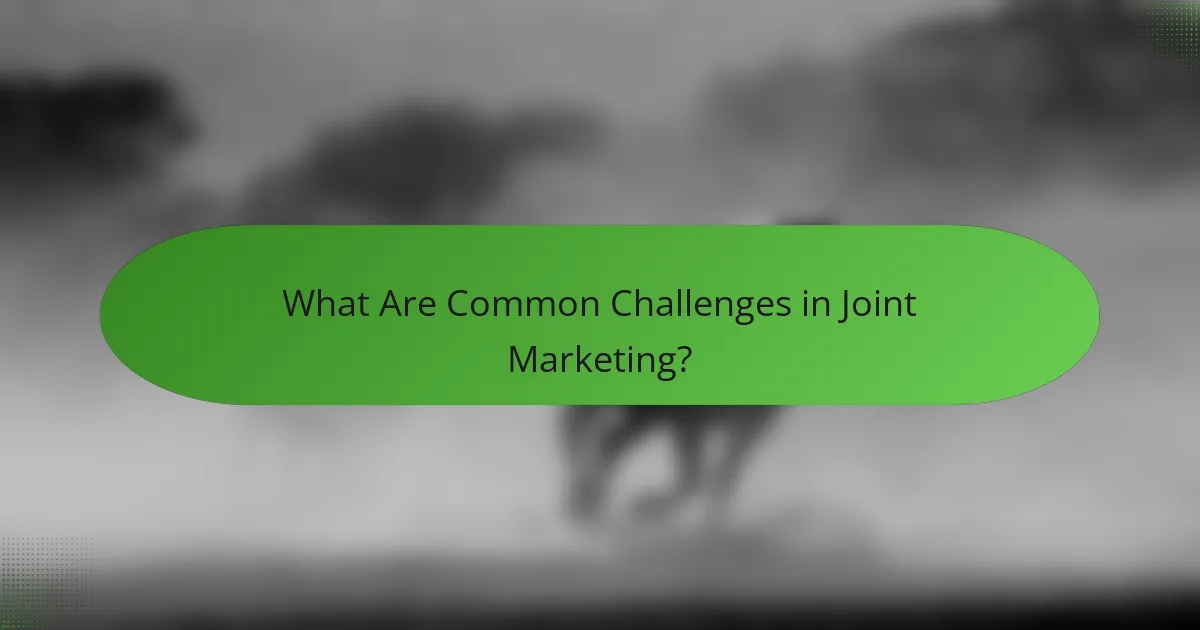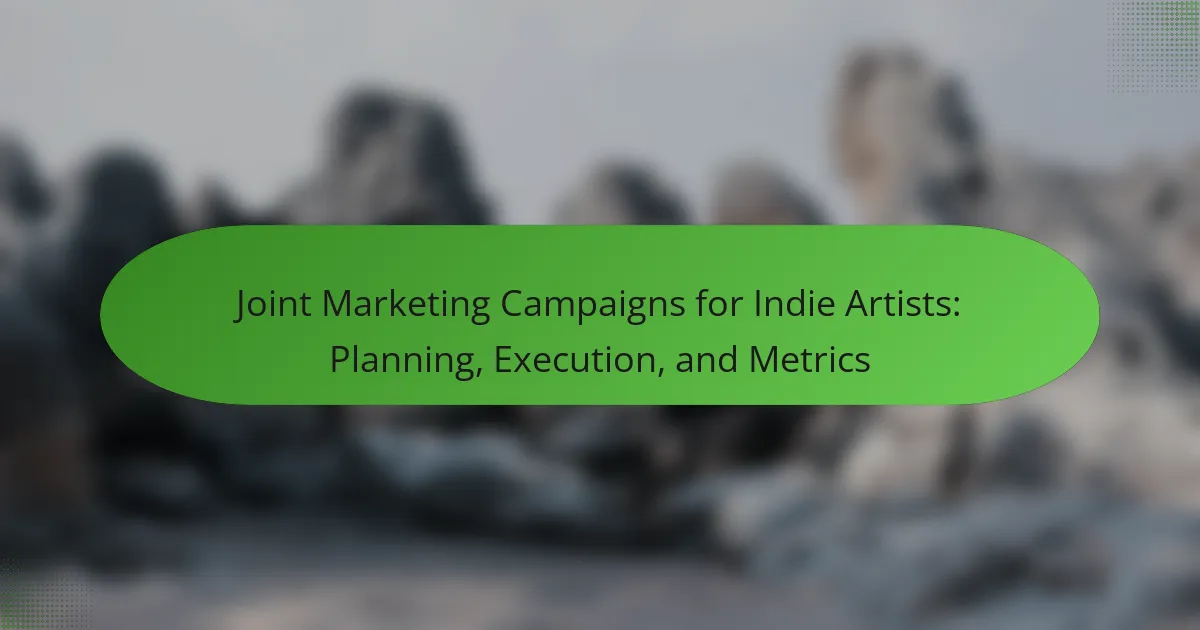Joint marketing campaigns offer indie artists a powerful way to enhance their visibility and engagement by pooling resources and audiences. By carefully planning objectives and executing strategies with clear communication, artists can present a unified front that maximizes their reach. Additionally, measuring success through performance metrics allows artists to evaluate the effectiveness of their collaborations and refine future efforts.

How to Plan Joint Marketing Campaigns for Indie Artists?
Planning joint marketing campaigns for indie artists involves setting clear objectives, collaborating effectively, and measuring success. A well-structured approach can enhance visibility and engagement while sharing resources and audiences.
Define campaign goals
Establishing clear campaign goals is crucial for guiding the entire marketing effort. Goals might include increasing social media followers, boosting streaming numbers, or enhancing brand awareness. Aim for specific, measurable objectives to track progress effectively.
For example, a goal could be to increase Spotify streams by 20% over three months. This clarity helps in aligning all partners on what success looks like.
Identify target audience
Understanding the target audience is essential for tailoring the campaign’s messaging and channels. Consider demographics such as age, location, and musical preferences to create a focused strategy. Use existing data from social media insights or streaming platforms to refine your audience profile.
For instance, if the campaign targets young adults aged 18-24 who enjoy indie rock, ensure that all promotional materials resonate with their interests and habits.
Choose collaborative partners
Selecting the right partners can amplify the campaign’s reach and impact. Look for artists or brands that share a similar audience but are not direct competitors. This synergy can enhance creativity and resource sharing.
For example, two indie artists with complementary styles could co-host a live event or collaborate on a single, benefiting from each other’s fan bases.
Set budget and resources
Establishing a budget is vital to ensure that all aspects of the campaign are financially viable. Consider costs for promotional materials, advertising, and any collaborative efforts. A reasonable budget range for indie campaigns might be a few hundred to a few thousand dollars, depending on the scale.
Allocate resources wisely, ensuring that each partner contributes fairly, whether through monetary support or promotional efforts.
Create a timeline
A well-defined timeline helps keep the campaign on track and ensures timely execution of tasks. Outline key milestones, such as the launch date, promotional phases, and evaluation periods. A typical campaign might span 2-3 months, allowing ample time for planning and execution.
Use project management tools to assign tasks and deadlines to each partner, ensuring accountability and smooth collaboration throughout the campaign.

What Are Effective Execution Strategies?
Effective execution strategies for joint marketing campaigns involve clear communication, coordinated efforts, and measurable goals. These strategies ensure that all participating indie artists present a unified front while maximizing their reach and engagement.
Develop a cohesive message
Creating a cohesive message is essential for joint marketing campaigns. This message should reflect the shared values and artistic vision of all participating artists, making it easier for audiences to connect with the campaign. Consider crafting a tagline or theme that resonates with both the artists’ identities and their target audiences.
To maintain consistency, all promotional materials, including graphics and written content, should align with this central message. Regular check-ins among the artists can help ensure that everyone is on the same page.
Utilize social media platforms
Social media platforms are powerful tools for reaching a wider audience in joint marketing campaigns. Artists should collaborate on content creation, sharing posts that highlight each other’s work while promoting the campaign as a whole. This approach can significantly increase visibility and engagement.
Focus on platforms where the target audience is most active, such as Instagram, TikTok, or Facebook. Utilize features like stories, reels, and live sessions to create dynamic content that showcases the artists’ personalities and talents.
Leverage email marketing
Email marketing remains a highly effective way to engage fans and promote joint campaigns. Artists can create a shared mailing list to send out newsletters that include updates, exclusive content, and event announcements. This direct communication fosters a sense of community among fans.
Consider segmenting the email list based on fan interests to tailor content more effectively. Regularly analyze open rates and click-through rates to refine email strategies and improve engagement over time.
Host joint events or livestreams
Hosting joint events or livestreams can create buzz and foster a deeper connection with fans. These events can range from virtual concerts to Q&A sessions, allowing artists to interact with their audiences in real-time. Collaborating on event planning helps share the workload and resources.
When organizing events, consider platforms like Zoom or YouTube Live, which can accommodate large audiences. Promote these events across all participating artists’ channels to maximize attendance and engagement.

How to Measure Success of Joint Marketing Campaigns?
Measuring the success of joint marketing campaigns for indie artists involves evaluating various performance metrics that reflect engagement, sales, audience perception, and brand visibility. By systematically analyzing these areas, artists can determine the effectiveness of their collaborative efforts and make informed decisions for future campaigns.
Track engagement metrics
Engagement metrics are crucial for understanding how audiences interact with the campaign. Key indicators include likes, shares, comments, and click-through rates on social media platforms and websites. Monitoring these metrics helps identify which content resonates most with the audience.
For instance, if a joint music video receives significantly more views and shares than previous solo efforts, it suggests a successful collaboration. Aim for a consistent increase in engagement compared to past campaigns, ideally in the range of 20-50% growth.
Analyze sales data
Sales data provides direct insight into the financial impact of the joint marketing campaign. Track metrics such as digital downloads, merchandise sales, and concert ticket purchases before, during, and after the campaign. Comparing these figures can reveal the campaign’s effectiveness in driving revenue.
Consider setting specific sales targets based on previous performance. For example, if a solo release typically generates $1,000 in sales, aim for a 30-50% increase during a joint campaign. This helps gauge whether the collaboration has successfully attracted new customers.
Gather audience feedback
Collecting audience feedback is essential for understanding perceptions of the joint marketing campaign. Use surveys, polls, or social media comments to gather insights about what the audience enjoyed and what could be improved. This qualitative data complements quantitative metrics.
For effective feedback collection, consider offering incentives for participation, such as exclusive content or discounts. Aim for a response rate of at least 10-15% to ensure the feedback is representative of your audience.
Evaluate brand awareness
Brand awareness measures how well the audience recognizes and recalls the artists involved in the campaign. Utilize tools like Google Trends, social media mentions, and brand sentiment analysis to assess changes in awareness levels. A successful campaign should lead to increased visibility for both artists.
To quantify brand awareness, consider conducting pre- and post-campaign surveys that ask participants about their familiarity with each artist. Look for a significant increase in recognition, ideally aiming for a 20-30% rise in awareness metrics following the campaign.

What Are Common Challenges in Joint Marketing?
Joint marketing campaigns can face several challenges that hinder their effectiveness. Understanding these issues is crucial for indie artists to navigate partnerships successfully.
Misaligned goals among partners
One of the primary challenges in joint marketing is misaligned goals among partners. Each artist may have different objectives, such as brand exposure, audience growth, or sales targets, which can lead to conflicts in strategy and execution.
To avoid this, partners should establish clear, shared goals at the outset. Regular check-ins can help ensure that all parties remain aligned and can adjust strategies as needed.
Budget constraints
Budget constraints can significantly impact the scope and success of joint marketing efforts. Indie artists often operate with limited funds, making it essential to allocate resources wisely across various marketing channels.
To manage budget limitations, partners should create a detailed budget plan that outlines expected costs and contributions from each party. Consider pooling resources for shared expenses, such as promotional materials or advertising, to maximize impact.
Communication issues
Effective communication is vital for the success of joint marketing campaigns, yet it is often a challenge. Misunderstandings or lack of transparency can lead to missed opportunities and frustration among partners.
Establishing clear communication channels and regular updates can mitigate these issues. Using project management tools or scheduled meetings can help ensure that everyone is on the same page and that tasks are completed on time.

What Tools Can Help Manage Joint Marketing Campaigns?
Effective management of joint marketing campaigns for indie artists relies on various tools that streamline collaboration, communication, and performance tracking. These tools can enhance coordination between artists and their teams, ensuring that campaigns run smoothly and achieve desired outcomes.
Project Management Software
Project management software, such as Trello or Asana, helps indie artists organize tasks, set deadlines, and assign responsibilities. These platforms allow teams to visualize progress and keep everyone aligned on campaign goals. Utilizing such tools can prevent miscommunication and ensure that all parties are aware of their roles and timelines.
When selecting project management software, consider user-friendliness and integration with other tools. A simple interface can facilitate adoption, especially for artists who may not be tech-savvy. Look for features like file sharing, comment sections, and notifications to enhance collaboration.
Social Media Management Tools
Social media management tools like Hootsuite or Buffer enable artists to schedule posts, engage with followers, and analyze performance metrics across multiple platforms. These tools are essential for maintaining a consistent online presence during a joint marketing campaign. They help ensure that promotional content is timely and reaches the target audience effectively.
Choose a tool that offers analytics to track engagement and reach. This data can inform future campaigns and help artists understand which types of content resonate with their audience. Regularly reviewing these metrics can lead to more effective strategies in subsequent promotions.
Email Marketing Platforms
Email marketing platforms, such as Mailchimp or Constant Contact, are crucial for reaching fans directly with campaign updates, exclusive content, and event announcements. These platforms allow artists to segment their audience and tailor messages, increasing the likelihood of engagement. A well-crafted email campaign can significantly boost attendance at events or sales of new releases.
Consider using A/B testing features to determine which subject lines or content formats yield better open and click-through rates. Regularly cleaning your email list to remove inactive subscribers can also improve overall campaign effectiveness and engagement rates.
Analytics Tools
Analytics tools like Google Analytics or social media insights provide valuable data on campaign performance, helping artists assess what works and what doesn’t. These tools track website traffic, user behavior, and conversion rates, offering insights into audience engagement. Understanding these metrics is vital for optimizing future campaigns.
Set clear goals for what you want to measure, whether it’s website visits, social media engagement, or sales conversions. Regularly reviewing these analytics will help refine strategies and improve overall campaign effectiveness, ensuring that resources are allocated efficiently.
